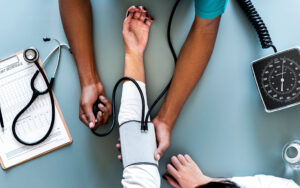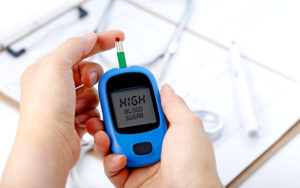Diabetes is a condition where your body either does not produce enough insulin or cannot properly use the insulin it produces. Insulin is a hormone produced by the pancreas.
Your body uses insulin to properly convert the sugars and starches in the foods we eat into glucose. Glucose is used by your body as fuel to create energy. The purpose of insulin is to regulate the body’s production and use of glucose. In doing so, it prevents a buildup of sugar in the bloodstream and ensures that assorted body tissues and organs have the proper amount of glucose to function efficiently. Although the actual cause of diabetes is unknown, three different types of disease have been identified.
What are the types of diabetes?
Type 1 Diabetes
Type 1 Diabetes occurs when the pancreas produces very little or no insulin. Only about 10% of people with diabetes have it. Type 1 diabetes is an autoimmune condition caused by the body attacking its own pancreas with antibodies. It used to be called juvenile-onset diabetes because it often begins in childhood and requires a permanent combination of insulin injections and lifestyle management.
Type 2 Diabetes
Type 2 Diabetes occurs when the pancreas produces insulin but it is not enough or the body is unable to use it effectively. About 90% of people with diabetes have Type 2. Most people with Type 2 diabetes can control the disease through lifestyle management. More severe cases of Type 2 diabetes may also require oral or injected medication
Gestational Diabetes
Gestational diabetes is a temporary condition that occurs in 2% to 4% of pregnant women. This type of diabetes usually disappears after the baby is born. However, women who have had gestational diabetes are at a greater risk of developing Type 2 diabetes in the future.
Who is at risk of getting diabetes?
More prevalent in people of Caucasian descent, Type 2 diabetes can occur under any circumstances. Risk factors for developing Type 2 diabetes include the following:
- Age – 45 years of age or older
- Weight – overweight people, especially with a lot of excess weight around the middle (Overweight children are also at risk for Type 2 diabetes)
- Family History – parents or siblings with diabetes. High-Risk Groups – Aboriginal peoples, and people of Asian, African or Hispanic descent
- Gestational diabetes – temporary diabetes during pregnancy or having given birth to a baby over 4kg (9 pounds)
- High cholesterol – or other fats in the blood
- High blood glucose levels
- High blood pressure or heart disease
What are the symptoms of diabetes?
The symptoms of Type 1 diabetes usually come on quickly and can include the following:
- Frequent urination
- Extreme hunger
- Extreme fatigue
- Sweet smelling breath
- Unusual thirst
- Unusual weight loss
- Blurred vision
Type 2 diabetes symptoms are often more discrete. They can include:
- Any of the symptoms of Type 1 diabetes
- Frequent or recurring infections – especially skin, gum and bladder infections
- Cuts and bruises that are slow to heal.
- Tingling and numbness in hands or feet
How is diabetes treated?
If it is managed effectively, people with diabetes
can expect to have active independent lives. This requires a commitment to lifestyle management which will allow you to maintain careful control of your blood sugar levels. People with Type 1 diabetes always require daily injections of insulin. More severe cases of Type 2 diabetes may also require some form of medication to assist in the control of the disease. Both forms of diabetes must also be managed in the following ways:
Education – Once you get to know your condition, you are better equipped to manage the situation. Diabetes can lead to many complications that can be prevented if you know how to effectively manage your lifestyle. The Canadian Diabetes Association, the Juvenile Diabetes Foundation Canada, and your PharmaChoice pharmacist can answer any questions that you may have concerning diabetes.
It is estimated that over 2 million Canadians have diabetes, but as many as one in three is unaware they have the disease because many people with Type 2 diabetes display no symptoms at all.










